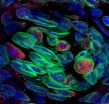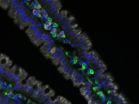(Press-News.org) BEER-SHEVA, ISRAEL, March 7, 2011 – Elderly drivers are half as likely to see pedestrians on the sidewalk due to a limited field of view, and compensate in part by driving more slowly, according to a study by Ben-Gurion University of the Negev (BGU) researchers.
In the online edition of Accident Analysis and Prevention, the study compared reaction times and perception of pedestrians as hazards between experienced elderly and non-elderly drivers.
The study was conducted in response to an increasing number of pedestrian-related accidents among elderly drivers. Age 65 and older, the elderly are the fastest growing group in the Western world and more elderly drivers than ever are on the road.
BGU researchers used two evaluation methods: driving in a traffic simulator while watching video of traffic scenes, and identifying hazardous situations by pressing a button. The results of the video observation method showed that elderly drivers took longer to respond to pedestrian hazards. Approximately half of the pedestrian-related events presented in the videos were difficult for elderly drivers to perceive when compared with the non-elderly drivers.
The simulator drive test also revealed that the elderly performed "braking actions" half as often as the non-elderly group in response to pedestrians on sidewalks and shoulders. However, the elderly group attempted to cope with hazards by reducing their driving speed by almost 20 percent, providing them more time to process the potential hazards and dangers, even if they couldn't detect them.
"These findings strengthen the notion that elderly drivers, shown to have a narrower useful field of view (UFV), may also be limited in their ability to detect hazards, particularly when outside the center of their view," explains Tal Oron-Gilad, a researcher in the BGU Department of Industrial Engineering.
She recommends that while more research is needed, "authorities should be aware of these limitations and increase elderly drivers' awareness of pedestrians by posting traffic signs or dedicated lane marks that inform them of potential upcoming hazards."
###
The research was conducted in BGU's Human Factors Laboratories, which features a 2008 Cadillac sedan and sophisticated simulation technology. The multidisciplinary lab recently developed one of the world's only pedestrian simulation labs to conduct research on how pedestrians perceive and react to drivers.
Other BGU researchers that participated in this study include Shani Bromberg, Adi Ronen, Avinoam Borowsky and Yisrael Parmet.
The study was supported in part by a scholarship from the Ran Naor Foundation.
About American Associates, Ben-Gurion University of the Negev
American Associates, Ben-Gurion University of the Negev (AABGU) plays a vital role in sustaining David Ben-Gurion's vision, creating a world-class institution of education and research in the Israeli desert, nurturing the Negev community and sharing the University's expertise locally and around the globe. With some 20,000 students on campuses in Beer-Sheva, Sede Boqer and Eilat in Israel's southern desert, BGU is a university with a conscience, where the highest academic standards are integrated with community involvement, committed to sustainable development of the Negev. AABGU is headquartered in Manhattan and has nine regional offices throughout the U.S. For more information, visit www.aabgu.org.
Elderly see pedestrians half as often as younger drivers, according to Ben-Gurion U. researchers
Elderly driver slower to compensate for more limited field of view
2011-03-08
ELSE PRESS RELEASES FROM THIS DATE:
RA sufferers armed with kitchen safety tool
2011-03-08
His design has earnt a spot on the first-round shortlist of one of the world's most prestigious design competitions - the Australian Design Award/James Dyson Award.
Twenty-four-year-old Ching-Hao (Howard) Hsu, who graduated with a Bachelor of Design (Industrial Design) at the end of 2010, designed the 'arthritis handle' after observing several sufferers of rheumatoid arthritis performing cooking tasks in their own kitchens.
RA is a chronic disease affecting one percent of the population - about 500,000 Australians. It involves inflammation of the joints, which can lead ...
Flipping a switch on neuron activity
2011-03-08
WASHINGTON, D.C. (March 7, 2011) -- All our daily activities, from driving to work to solving a crossword puzzle, depend on signals carried along the body's vast network of neurons. Propagation of these signals is, in turn, dependent on myriad small molecules within nerve cells -- receptors, ion channels, and transmitters -- turning on and off in complex cascades. Until recently, the study of these molecules in real time has not been possible, but researchers at the University of California at Berkeley and the University of Munich have attached light-sensing modules to ...
Body mass index and risk of death in Chinese population
2011-03-08
Chinese people with a body mass index (BMI) of 24-25.9 had the lowest risk of death, according to a study published in CMAJ (Canadian Medical Association Journal) (pre-embargo link only) http://www.cmaj.ca/embargo/cmaj101303.pdf
Obesity has increased significantly across the globe and the World Health Organization (WHO) estimates that about 2.3 billion adults will be overweight and more than 700 million will be obese by 2015. Overweight and obesity are associated with increased risks of heart disease, diabetes, cancer and other chronic diseases.
As white populations ...
Dementia risk is higher in people with both stroke and irregular heartbeat
2011-03-08
Stroke patients who also suffer from an irregular heartbeat are at double the risk of developing dementia, according to a new study by the University of East Anglia (UEA).
Published tomorrow in the journal Neurology, the findings show that stroke survivors with an irregular heartbeat – or atrial fibrillation - are 2.4 times more likely to develop dementia than stroke survivors without the heart condition.
The researchers analysed 15 studies with more than 45,000 participants and an average age of 72. They compared patients with and without atrial fibrillation, and ...
Stroke survivors with irregular heartbeat may have higher risk of dementia
2011-03-08
ST. PAUL, Minn. – Stroke survivors who have an irregular heartbeat called atrial fibrillation may be at higher risk of developing dementia than stroke survivors who do not have the heart condition, according to research published in the March 8, 2011, print issue of Neurology®, the medical journal of the American Academy of Neurology.
Atrial fibrillation affects more than two million Americans, and it is more common as people age. About 15 percent of strokes occur in people with atrial fibrillation. The heart's two upper chambers do not beat effectively in the condition, ...
Mediterranean diet: A heart-healthy plan for life
2011-03-08
The Mediterranean diet has proven beneficial effects not only regarding metabolic syndrome, but also on its individual components including waist circumference, HDL-cholesterol levels, triglycerides levels, blood pressure levels and glucose metabolism, according to a new study published in the March 15, 2011, issue of the Journal of the American College of Cardiology. The study is a meta-analysis, including results of 50 studies on the Mediterranean diet, with an overall studied population of about half a million subjects.
"The prevalence of the metabolic syndrome is ...
Diabetes belt identified in southern United States
2011-03-08
San Diego, CA, March 8, 2011 – In the 1960s, a group of U.S. states with high age-adjusted stroke mortality defined a "stroke belt." Until recently, geographic patterns of diabetes had not been specifically characterized in the same manner. In an article published in the April 2011 issue of the American Journal of Preventive Medicine, researchers were able to identify clustered high prevalence areas, or a "diabetes belt" of 644 counties in 15 mostly southeastern states using data compiled for the first time of estimates of the prevalence of diagnosed diabetes for every ...
How sweet it is: Why your taste cells love sugar so much
2011-03-08
PHILADELPHIA (March 7, 2011) – A new research study dramatically increases knowledge of how taste cells detect sugars, a key step in developing strategies to limit overconsumption. Scientists from the Monell Center and collaborators have discovered that taste cells have several additional sugar detectors other than the previously known sweet receptor.
"Detecting the sweetness of nutritive sugars is one of the most important tasks of our taste cells," said senior author Robert F. Margolskee, M.D., Ph.D., a molecular neurobiologist at Monell. "Many of us eat too much sugar ...
Researchers define a new type of secretory cell in the intestine
2011-03-08
The intestinal epithelium consists of four main specialized cell lineages: absorptive enterocytes and three secretory cell types known as enteroendocrine, Paneth, and goblet cells. But a rare, fifth type of intestinal cell called tuft cells also exists. Defined by the thick brush of long microvilli that project from their apical surface, tuft cells are seen in several epithelial tissues, yet little is known about their function due to a lack of tuft cell–specific markers.
In the March 7 issue of The Journal of Cell Biology (www.jcb.org), a team of French researchers ...
Parkinson's disease may be caused by microtubule, rather than mitochondrial complex I, dysfunction
2011-03-08
Patients with Parkinson's disease (PD) suffer a specific loss of dopaminergic neurons from the midbrain region that controls motor function. The exact mechanism of this selective neurodegeneration is unclear, though many lines of evidence point to dysfunctional mitochondrial complex I as one root cause of the disease. Yet new research now suggests that defective regulation of microtubules may be responsible for at least some cases of PD. The study appears in the March 7 issue of The Journal of Cell Biology (www.jcb.org).
Mitochondria were first implicated in PD when ...
LAST 30 PRESS RELEASES:
The vast majority of US rivers lack any protections from human activities, new research finds
Ultrasound-responsive in situ antigen "nanocatchers" open a new paradigm for personalized tumor immunotherapy
Environmental “superbugs” in our rivers and soils: new one health review warns of growing antimicrobial resistance crisis
Triple threat in greenhouse farming: how heavy metals, microplastics, and antibiotic resistance genes unite to challenge sustainable food production
Earthworms turn manure into a powerful tool against antibiotic resistance
AI turns water into an early warning network for hidden biological pollutants
Hidden hotspots on “green” plastics: biodegradable and conventional plastics shape very different antibiotic resistance risks in river microbiomes
Engineered biochar enzyme system clears toxic phenolic acids and restores pepper seed germination in continuous cropping soils
Retail therapy fail? Online shopping linked to stress, says study
How well-meaning allies can increase stress for marginalized people
Commercially viable biomanufacturing: designer yeast turns sugar into lucrative chemical 3-HP
Control valve discovered in gut’s plumbing system
George Mason University leads phase 2 clinical trial for pill to help maintain weight loss after GLP-1s
Hop to it: research from Shedd Aquarium tracks conch movement to set new conservation guidance
Weight loss drugs and bariatric surgery improve the body’s fat ‘balance:’ study
The Age of Fishes began with mass death
TB harnesses part of immune defense system to cause infection
Important new source of oxidation in the atmosphere found
A tug-of-war explains a decades-old question about how bacteria swim
Strengthened immune defense against cancer
Engineering the development of the pancreas
The Journal of Nuclear Medicine ahead-of-print tip sheet: Jan. 9, 2026
Mount Sinai researchers help create largest immune cell atlas of bone marrow in multiple myeloma patients
Why it is so hard to get started on an unpleasant task: Scientists identify a “motivation brake”
Body composition changes after bariatric surgery or treatment with GLP-1 receptor agonists
Targeted regulation of abortion providers laws and pregnancies conceived through fertility treatment
Press registration is now open for the 2026 ACMG Annual Clinical Genetics Meeting
Understanding sex-based differences and the role of bone morphogenetic protein signaling in Alzheimer’s disease
Breakthrough in thin-film electrolytes pushes solid oxide fuel cells forward
Clues from the past reveal the West Antarctic Ice Sheet’s vulnerability to warming
[Press-News.org] Elderly see pedestrians half as often as younger drivers, according to Ben-Gurion U. researchersElderly driver slower to compensate for more limited field of view



